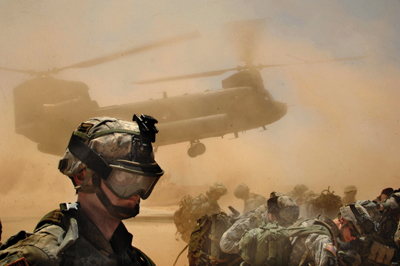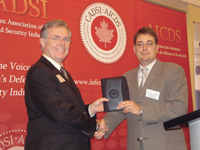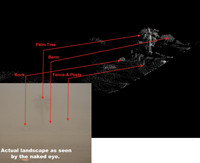
Features
Night Vision Lessons
Ideally, night vision and electro optical (NVEO) equipment enhance the safe operation of airplanes and helicopters in low-light conditions
April 14, 2010 By James Careless
Ideally, night vision and electro optical (NVEO) equipment enhance the safe operation of airplanes and helicopters in low-light conditions. In reality, however, these systems can actually make flying more dangerous if the systems haven’t been thoughtfully integrated into a pilot’s operational regime.
 |
| Night vision goggles can also be useful for the Canadian Forces in Afghanistan, where brownouts (dust storms) are major hazards for pilots flying desert missions.
|
“We’re finding there’s a common thread in the military and the civil sector that is showing bringing new technology into the cockpit is not necessarily making the flying better or safer,” said Ian McIntyre, VP Training with Gladstone Aerospace Consulting (GAC) in Ottawa. “People have these things – these tools – [and] they know how to use one or two of them, but they don’t know how to integrate them so that they lighten up their workloads a bit, make them more efficient, or [ensure that] they’re flying safer.”
To address this problem, GAC teamed with the Canadian Association of Defence and Security Industries (CADSI) to hold the Night Vision and Electro Optical Conference 2009 (NVEO 2009) in Ottawa. Staged at the Marriott Hotel from Nov. 16-17, NVEO 2009 brought together military and civilian users with research and industry experts to examine the best ways to operate NV/EO systems safely.
The conference
NVEO 2009 featured presentations covering various aspects of NVEO research, trials, deployments, and lessons learned – plus a small trade show comprised of NVEO vendors. The overarching impact, from an attendee’s standpoint, was a two-day crash course in all things NVEO.
 |
| (LtoR): Ian McIntyre, Gladstone Aerospace, with Dr. George Leblanc, from the NRC.
|
On the fixed-wing side, Major William Radiff spoke about the deployment of night vision systems in the Canadian Forces’ CF-18s. He told delegates that the CF pilots who collectively tested the system were careful and methodical in their approach. Much of the testing time was spent flying with night vision goggles in all kinds of terrain, to develop a uniquely Canadian understanding of the technology. “We spent a lot of time just gaining hours,” said Major Radiff. “Although people have been flying with night vision goggles for a long time, no one flies the way that we do.”
Indeed, Canada’s CF-18 pilots have to deal with unique challenges, such as wearing night vision goggles while the Northern Lights are ablaze overhead. As a result, safety came first, Major Radiff told delegates: For instance, the testing flights were always flights that could be executed without goggles, to ensure that the flights could be landed safely should the technology run into difficulties. This notwithstanding, the tests were a “great success,” he said. “Two months after implementation, people were dropping bombs.”
National Research Council engineer Sion Jennings was on hand to explain the NRC’s efforts to develop better low-level and dust-obscured vision systems. “Right now, if your naked eye can’t see through a brownout, it is doubtful that a sensor can,” Jennings told the audience. This is why the NRC is studying “augmented vision systems” that integrate other resources, such as terrain databases used in flight simulators, to improve flight safety in poor visibility conditions.
There are numerous risks with such an approach as Jennings proved by showing a satellite photo of the Statue of Liberty rotated to represent a pilot’s eye view of the site. In the image, the statue’s base and shadow were clearly visible, but the statue’s true height was missing – simply because a top view does not provide such data. However, if the satellite imagery is combined with an onboard LIDAR scan and infrared imagery, the three can be used to create a reasonable 3-D model. This kind of data can then be viewed by a pilot in visually obscured conditions, providing a safe way to navigate in this space.
Night vision goggles can also be useful for the Canadian Forces in Afghanistan, where brownouts (dust storms) are major hazards for pilots flying desert missions. So how can pilots see through the dust? One possible answer is Obscurant Penetrating Autosynchronous LiDAR, or OPAL for short. Developed by Ottawa’s Neptec Design Group – and explained during an NVEO 2009 session by Neptec OPAL project manager Evan Trickey – OPAL uses LiDAR to ‘look through’ dust and snow, providing clear images to an in-cockpit display. (Note: LiDAR is an acronym for Light Detection And Ranging. It uses laser light, rather than radio waves, to detect objects.)
Recent trials at the Yuma Proving Ground (operated by the U.S. Army in Phoenix, Ariz.) proved the OPAL concept. A brownout generated by a UH-1 was ‘seen through’ using both ground- and air-mounted OPAL units. Using multiple LIDAR scans of the target area, which had been filled with various obstacles, “we were able to distinguish rocks from trees,” said Trickey. “We could see wires 1/8 inch to 1/2 inch in diameter, and rebar.”
A second way to improve low-light flying is to improve aircraft handling, to give pilots more time to focus on obstacle detection. To this end, the NRC has been testing handling enhancements and brownout avionics symbology (for flight instruments) on its Bell 205 and 412 helicopters. The technology, which is due for testing at the Yuma Proving Grounds, “is suitable now for rapid integration with Canadian Forces helicopters,” Jennings said.
Introducing night vision goggles into the CF’s Sea King fleet was the subject of Lt. John Schein’s talk. The bad news: At this point the navy only has one Sea-King modified for night vision use. “When she breaks, you don’t go flying,” he said. The good news is that the rest of the Sea King fleet are scheduled to be modified for night vision flight.
Other topics covered at NVEO 2009 included virtual training systems for night operations, inspection and maintenance of NVIS crew stations, and a potential detection method for finding IEDs (Improvised Explosive Devices) using airborne polarized shortwave infrared hyperspectral imaging.
Reflections on NVEO technology
Overall, NVEO 2009 provided pilots and aircraft operators with an in-depth look at night vision and electro optical technology. It also begged the question: If night vision technology is so effective, then why are so many air ambulances experiencing accidents?
 |
| Developed by Ottawa’s Neptec Design Group, OPAL (Obscurant Penetrating Autosynchronous LiDAR ‘looks through’ dust and snow, providing clear images to an in-cockpit display.
|
The answer, said McIntyre, is that the vast majority of accidents are happening south of the Canada-U.S. border. Here in the Great White North, Transport Canada requires air ambulance crews to have two pilots, not one. As well, if they use night vision goggles, both pilots must wear them. This ensures that “both pilots are operating in the same Crew Resource Management regime,” he says.
In the United States, the situation is altogether different. There is no requirement for two-pilot air ambulance crews, so many operators get by with just one person in the cockpit. Add the fact that many air ambulance helicopters are not equipped for IFR – nor have any form of night vision/collision avoidance technology – and the reasons for many of the crashes becomes clear.
“Thanks to the two-pilot system and their own operations management, STARS (The Alberta Shock Trauma Air Rescue Society) has been able to integrate night vision goggles safely and competently,” McIntyre said. “The impact on transport time to patients and then to hospital has been significant. For instance, when STARS would fly into Cranbrook without night vision goggles, they would have to gain altitude to fly over the mountains both there and back; a diversion that added an hour to their flight time. Now, with night vision goggles, they can fly through the valleys as they would in VFR conditions. The result is better medical care for patients, and enhanced flight safety for everyone on board.”
Will things change for the better in the U.S.? Ian McIntyre believes that they will. “Our understanding is that the FAA is thinking of making it mandatory for air ambulance operators to have night vision capability,” he said. “That would make a major difference, but what would really improve things is for the FAA to require two-pilot air ambulance crews. If that happened, however, I suspect that a number of the smaller private operators would go out of business, depriving some communities of air ambulance service. So you can make arguments on either side of the issue.”
The value and risks of NVEO systems
As was proven by presentation after presentation at NVEO 2009, night vision and electro optical detection systems make safe night and low-light flying possible. In contrast, flying without such aids is asking for trouble, a point that was made by Lt. Schein when he described being assigned to Sea King flight duty. “I was used to flying at night with night vision goggles,” he told the audience. Subsequently, after having to fly a shipboard Sea King at night without night vision goggles, with visibility at near-zero and “snakes of snow in the wind,” Lt. Schein told his CF cohorts, “you guys are nuts!”
On the flip side, night vision goggles and electro optical systems come with their own risks. “People do make this mistake with NVEO technology; they think just having it makes them safer, whereas proper training and operational integration is a must,” said McIntyre. “With FLIR (forward looking infrared systems), they push the limits of image sensing without understanding the implications. They get a capability like night vision goggles and they don’t realize how to optimize them to their best advantage. It is vital to respect the limits and integrate such systems into your cockpit routine, to truly benefit from them safely.”
The bottom line: NVEO systems, when properly used by trained pilots, do save lives and make night flight far safer. That was the message of NVEO 2009 – a message that the 100-plus attendees received loud and clear.